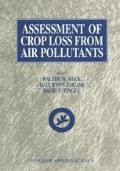Abstract
In biblical times, prophets predicted crop status and recommended measures by which famine could be averted. The economic, social, political and environmental importance of crop production still dictate the need for large area crop assessment systems. To the extent that levels of crop production can be predicted with some degree of accuracy, appropriate actions can be taken by individuals and groups to buy and sell, to replenish or reduce reserves, to redistribute supplies to areas of shortage, to utilize alternative crop products for specific purposes, and to negotiate appropriate prices.
Access this chapter
Tax calculation will be finalised at checkout
Purchases are for personal use only
Preview
Unable to display preview. Download preview PDF.
References
Adams, R. M. and B. A. McCarl. (1985). Assessing the benefits of alternative oxidant standards on agriculture: the role of response information. J. Environ. Econ. Managmt, 12, 264–76.
Carmer, S. G. and W. M. Walker. (1988). Significance from a statisticians viewpoint. J. Prod. Agr. (in press).
King, D. A. and W. L. Nelson. (1987). Assessing the impacts of soil moisture stress on regional soybean yield and its sensitivity to ozone. Agric. Ecosys. Environ., 20, 23–35.
LeDuc, S. K. and D. A. Holt. (1988). The scale problem: modeling plant yield over time and space. In Plant growth modeling for resource management, Vol. 1, Current Models and Methods, ed. by K. Wisiol and J. D. Hesketh. Boca Raton, FL, CRC Press (in press).
Onstad, D. W. and W. G. Ruesink. (1986). Simulation model of the epizootiology of a microsporidium infecting an insect. In Fundamental and applied aspects of invertebrate pathology, ed. by R. A. Sampson, J. M. Flak, and D. Peters, Wageningen, The Netherlands, The Foundation of the Fourth International Colloquium of Invertebrate Pathology, 576–9.
Shaw, L. H. and D. D. Durost. (1965). The effect of weather and technology on corn yields in the corn belt, 1929–62. Agricultural Economic Report No. 80. United States Department of Agriculture, Economic Research Service.
Taylor, C. R. (1987). The fading curse of dimensionality. University of Illinois Agricultural Economics Staff Paper No. 87 E-385.
Author information
Authors and Affiliations
Editor information
Editors and Affiliations
Rights and permissions
Copyright information
© 1988 Elsevier Science Publishers Ltd.
About this chapter
Cite this chapter
Holt, D.A. (1988). Crop Assessment: International Needs and Opportunities. In: Heck, W.W., Taylor, O.C., Tingey, D.T. (eds) Assessment of Crop Loss From Air Pollutants. Springer, Dordrecht. https://doi.org/10.1007/978-94-009-1367-7_2
Download citation
DOI: https://doi.org/10.1007/978-94-009-1367-7_2
Publisher Name: Springer, Dordrecht
Print ISBN: 978-94-010-7109-3
Online ISBN: 978-94-009-1367-7
eBook Packages: Springer Book Archive

